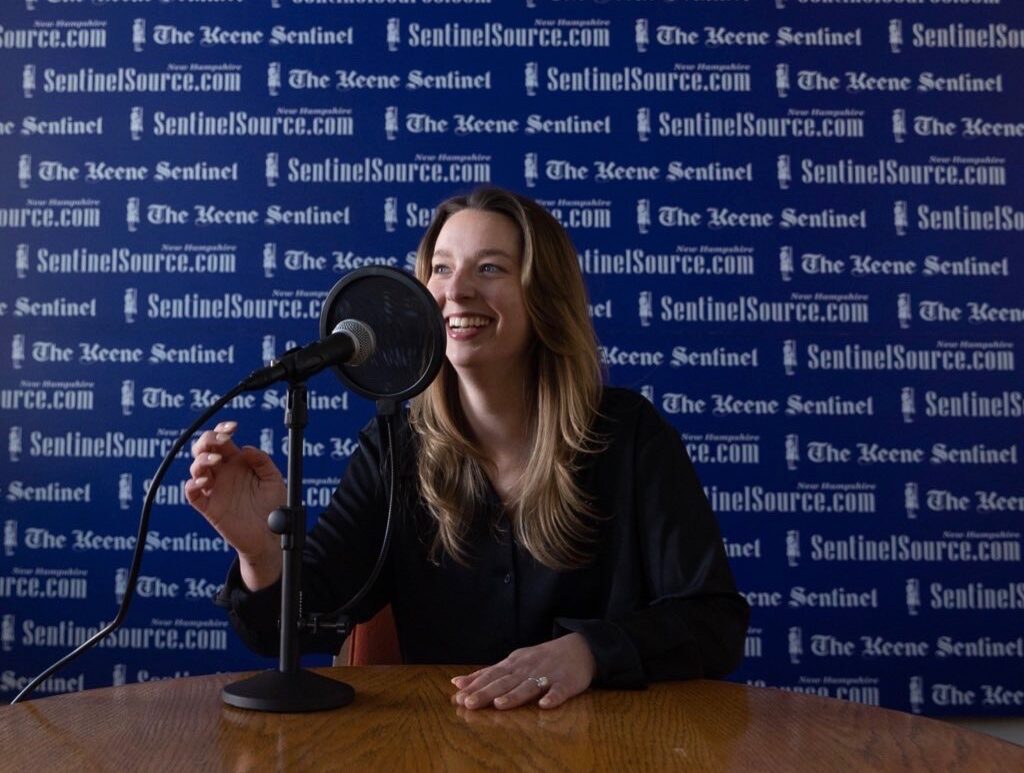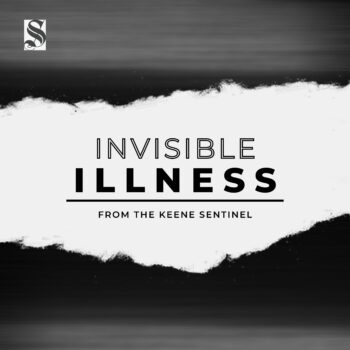How The Keene Sentinel learned valuable lessons from a health-related podcast
Olivia Belanger and James Rinker,, The Keene Sentinel,
Olivia Belanger, a health solutions reporter at The Keene Sentinel, hosts the podcast "Invisible Illness." (Hannah Schroeder/The Keene Sentinel)
Here’s an idea to steal and adapt: The Keene Sentinel added video and transcripts to a local health podcast to make each episode as accessible as possible.This is a series on Better News to a) showcase innovative/experimental ideas that emerge from the Knight-Lenfest Newsroom Initiative and b) share replicable tactics that benefit the news industry as a whole.
This “win” comes from Olivia Belanger, health solutions reporter, and James Rinker, digital community engagement journalist, both of The Keene Sentinel, which participated in the 2019-20 Poynter Table Stakes program, API’s digital subscriptions sprint cohort for Table Stakes alumni in 2022, and the American Press Institute-News Product Alliance product development sprint in 2023.
Question: What problem were you trying to solve, and why was that problem strategically important to your organization?
Answer: As a legacy print newspaper, The Sentinel is always looking for new ways to engage younger audiences and remain relevant in the ever-changing news landscape. We identified, through community research, that the people we were trying to reach were looking for more local multimedia content.
Q: How did you go about solving the problem?
 A: When we decided to focus on multimedia, we took stock of what seemed feasible for us to produce. The previous year, we launched a podcast, “Invisible Illness,” where each episode focused on a person who lived with a disease that was not outwardly visible. The first four episodes had a decent reception, so we decided to add to this already established project. For the second season of “Invisible Illness,” we added videos of the interviews, alongside the audio and full transcripts, to try a different format and make the episodes as accessible as possible.
A: When we decided to focus on multimedia, we took stock of what seemed feasible for us to produce. The previous year, we launched a podcast, “Invisible Illness,” where each episode focused on a person who lived with a disease that was not outwardly visible. The first four episodes had a decent reception, so we decided to add to this already established project. For the second season of “Invisible Illness,” we added videos of the interviews, alongside the audio and full transcripts, to try a different format and make the episodes as accessible as possible.
Q: What worked?
A: We started making a marketing plan early on, which included a schedule for posting on social media. Crafting even a rough plan for sharing our work was crucial to getting the word out to as many people as possible.
We wanted to make sure people knew about what we were doing not only ahead of the launch days, but also in the weeks and months following them. Last season, we really didn’t have the time to do this, because it was just the two of us working on the podcast from development to production. Our marketing wasn’t as strong as it could have been.
It helped to form a larger production team. Our staff visual journalist, Hannah Schroeder, filmed the video component and we hired a freelancer to edit the final cuts of the episodes.
Adding a video component helped us reach a wider audience. The first episode did really well on YouTube with 485 views, and both episodes this season saw over 50 downloads each through Apple Podcasts. Adding a video component also helped us get more data about engagement time. We learned that shorter videos might perform better, a lesson we can bring to future multimedia work.
On YouTube, viewers watched our first episode for an average of 4 minutes and 10 seconds, while the second episode averaged 5 minutes and 53 seconds.
The podcast was produced through The Sentinel’s Monadnock Region Health Reporting Lab. Funding for the lab comes from several sources, including The Sentinel and several local businesses and private donors, along with support from the Granite State News Collaborative. The newsroom maintains full editorial control over all content produced by the lab.
Q: What didn’t work?
A: We realized after conducting our initial audience research that while people really wanted multimedia content, we didn’t ask them which topics would interest them in this format. James will conduct more audience research about multimedia wants and needs in April, which will include more targeted questions about topics of interest in podcast and video formats.
Each of the two episodes took us about two months to produce. We started with the pre-production work, such as recruiting potential guests, scheduling interviews and writing and editing the script for Olivia’s intro/outro and the guiding questions for the episode.
Then we tackled the actual production itself: recording those interviews, listening through to identify potential places we could cut and make notes of significant timestamps for promotion and editing the episodes for both audio and video. The post-production work took a week, mostly social media marketing and planning and creating the media kit.
Q: What happened that you didn’t expect?
A: Last season, we launched all of the episodes at once. However, we noticed that the last two episodes in the season didn’t get as much engagement as the first two.
We decided to release the episodes for this season a week apart to try to level out how many people listened or watched to each of the two episodes. After getting data from the past month, we were shocked to discover that our first episode had 10 times more views on YouTube than the second episode.
As of March 25, our first episode had 52 downloads through Buzzsprout and our second episode had 55. The average viewing time for both on YouTube was roughly five-and-a-half minutes. Both episodes also did equally well on podcasting platforms like Spotify and Apple Podcasts.
We’re still super-stumped about what happened on YouTube! We did the same social media marketing and in-house print and online advertising for both episodes. We’re glad we tried it though.
Q: What advice would you give to others who try to do this?
A: Given the overall metrics of the second season, we have decided not to move forward with “Invisible Illness” as a podcast. However, we are open to exploring different mediums for this project, such as traditional print stories or short social media clips.
Even though we are discontinuing this podcast, we learned many valuable lessons.
Be flexible with the time frame for multimedia projects. For newsrooms with smaller staffs and/or limited multimedia resources, start small.
Short-form video and “bite-sized” daily news podcasts are a great place to start. They’re easier to learn on the production side, take less time to create and can be more accessible for your audiences. A lot more people might have five minutes of their day to spare to listen to a news podcast than have a half hour.
Make sure you can commit to being consistent with production and publication. For us, it took almost a year between the launch of our first season and the second. If your audiences don’t know when the next episodes are going to come out, then it’s difficult to retain them.
Make this a team effort. Identify stakeholders early on and keep them all in the loop on a regular basis. A product like this needs a team of more than just three people. For us, an ideal team for any sort of multimedia product includes at least one host – the face of the product – and three production staff, one of whom could lead the team in an executive position.
Don’t be afraid to try something new, but get the data to back it up. We were really interested in this topic, but we didn’t do enough to determine if our audiences were intrigued, too.